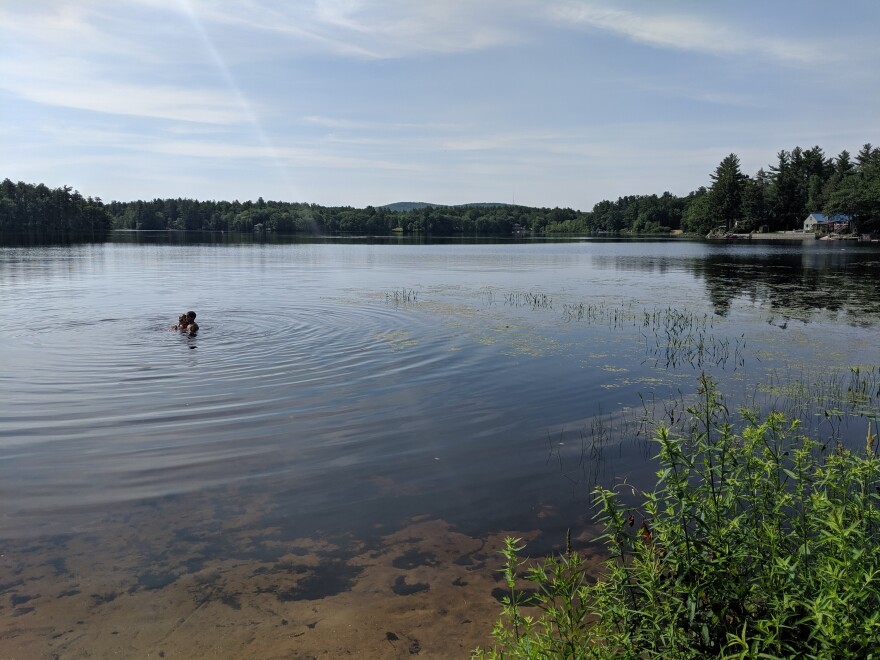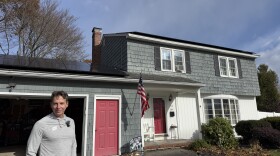The state is out with a first-of-its-kind report on the health of New Hampshire’s lakes, showing the effects of climate change, population growth and a decline in acid rain.
The report takes a comprehensive look at water quality trends from the past few decades or longer in 150 of the state’s lakes and ponds monitored by volunteers and state biologists.
These water bodies are key economic drivers, wildlife habitats and sources of drinking water.
This new analysis (click here to read a summary) was required by a 2016 Department of Environmental Services policy, and will be updated every five years from now on.
Its initial findings offer a baseline of data that sheds light on long-running questions about how New Hampshire’s lakes are changing, especially due to human activity. Here are some of the statistically significant trends the state found:
1. The annual number of fecal bacteria and cyanobacteria advisories, which limit recreational activities at lakes and beaches, rose from 2003 to 2018.
The state says the rise in E. coli warnings could be due to warming waters, more people using lake beaches, greater bird populations or increased stormwater runoff.

For cyanobacteria, which can create harmful toxins, it says public awareness and sampling efforts are on the rise – but the increase could also stem from excess nutrients in unhealthy lakes or warming waters due to climate change.
2. Most lakes didn’t see significant changes in their temperature, acidity or murkiness, but nearly all of those that did became warmer, less acidic and more murky – effects of both climate change and recovery from acid rain.
The report says 18% of lakes became warmer at a meter below the surface in recent decades – a statistically significant change for the state’s most common kinds of lakes, especially in the Lakes Region and Western New Hampshire.
Sixteen percent of lakes also became less clear from 1991 to 2018, especially in the White Mountains and Dartmouth-Lake Sunapee region. The state says this effect, known as “browning,” comes from dissolved organic carbon, or DOC, in the water:
The increase in DOC is partially attributed to reductions in the acid rain-causing pollutant, sulfur dioxide. The reduction of acid deposition has increased forest soil pH, which has led to increased mobility of organic matter which allows more terrestrial DOC to move from forests to waterbodies.
Over the past several decades, the Clean Air Act has sharply lowered emissions like sulfur dioxide from coal-fired power plants. This caused acid rain to decline in the Northeast, and the state report says some of the data from New Hampshire’s lakes reflect that. Nearly 13% of lakes, especially in Western New Hampshire, have seen an increase in pH.

The state also found signs in its lakes of the harms of global warming -- especially heavier precipitation, which also may be accelerating browning and other effects.
The report notes that New Hampshire’s air temperature has increased about 3.6 degrees Fahrenheit since the late 1800s, due to fossil fuel use and other human activity.
3. Average ice-out dates, when lakes fully thaw in the spring, are now coming about two weeks earlier than they did in the 1930s.
The state says the average spring thaw of the state’s lakes now occurs in mid-April, compared to early May in 1937, the earliest year when enough records were available for a reliable analysis.
This is the first time the state has pieced together enough data to find a statistically significant, statewide trend in ice-out times. They note that these earlier spring thaws can negatively affect winter tourism activities, and harm lake ecosystems:
Environmentally, earlier ice-out allows lake water to begin warming sooner, stimulating plant and algal growth. Earlier ice-out will result in hotter summer water temperatures, lower water levels due to increased evaporation, and prolonged summer lake stratification, which may lead to longer periods and/or greater areas of depleted oxygen in lake bottom waters. These changes are favorable for more rapid eutrophication (i.e. aging [or decreased productivity]) of waterbodies and cyanobacteria growth.
The state did not have enough data to draw any conclusions about ice-in dates, when lakes freeze over in late fall. Residents are encouraged to submit their own observations of lake ice.
4. The number of lakes with invasive species has steadily increased, but these infestations are now being controlled more often with methods other than herbicides.
The state documented 113 invasive species infestations in 89 water bodies in 2018, after a steady uptick from 48 water bodies in 2000. They say the acreage affected by invasive species hasn’t changed significantly, and the area treated with herbicides has remained about the same.

But they also found that, in the past decade, more lake managers began trying to control invasive species with alternatives to herbicides where practical.
The increase was driven by a method known as diver-assisted suction harvesting. Other alternatives include hand-pulling and the installation of physical barriers to block sunlight from reaching invasive plants.
5. Lakes appear to be seeing more runoff from road salt, a possible consequence of increased development and population growth.
The state analyzed two factors that reflect an increase in salt runoff: the alkalinity and conductivity of lakes. Both have generally increased, especially in the past decade.
About 60% of lakes, especially in Western New Hampshire, saw an increase in alkalinity. This means they’re less able to resist pH changes by neutralizing acidic inputs.

Granite bedrock gives the lakes a generally low starting alkalinity, which was at one point made lower by decades of acid rain. Now, as lakes recover from that, the state says alkalinity is increasing even more due to salt from road deicing and water-sewer systems. Drastic pH changes can harm aquatic life.
Forty percent of the state’s lakes, especially in the Lakes Region and Merrimack Valley, saw an increase in a measure called specific conductivity, while just over half saw no change. This measures water’s ability to carry an electrical current, which shows its level of dissolved solids – common metals and nutrients with conductive ions:
These ions originate from natural (bedrock) and anthropogenic (fertilizers, road salt, stormwater run-off, septic systems, agricultural practices) sources. These ions can have secondary influences on other water quality parameters.
The report notes that Southern New Hampshire’s population is expected to increase in the coming decades, likely leading to more development, paving, impervious surfaces and runoff of materials like salt that can exacerbate these water quality issues.
Much of the state lakes report is based on volunteer and citizen data. You can learn how to get involved at your lake through the DES Volunteer Lake Assessment Program.








